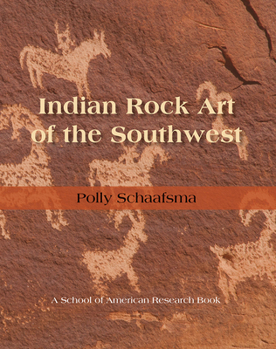Indian Rock Art of the Southwest
Select Format
Select Condition 
Book Overview
This comprehensive view of carvings and paintings on stone by Native Americans from 200 B.C. through the nineteenth century surveys the rock art of Utah, Arizona, New Mexico, northern Mexico, and west Texas, providing an incomparable visual record of Southwest Indian culture, religion, and society. Rock carvings and paintings are important sources in the archaeological and historical interpretation of Southwest Indians. Rock art reflects the cosmic and mythic orientation of the culture that produced it, and understanding of prehistoric peoples, both hunters and gatherers and the Hohokam, Anasazi, Mogollon, and Fremont cultures, and the Pueblo, Navajo, and Apache Indians. Culturally significant events such as the shift in prehistoric times from spear and atlatl to the bow, or, in the historic period, the introduction of the horse into the Southwest, are recorded in rock art. The illustrations--thirty-two color plates, nearly 250 photographs, and numerous line drawings--bring together in one volume petroglyphs and rock paintings that are scattered over thousands of miles of desert and mesa, giving the reader an overview of Indian rock art that would be nearly impossible to achieve in the field. Indian Rock Art of the Southwest examines from an archaeological perspective the rich legacy of stone drawings and carvings preserved throughout the Southwest. Professional and amateur archaeologists and historians, as well as the general reader with an interest in Indian art, will find this volume a valuable resource.
Format:Hardcover
Language:English
ISBN:0826309135
ISBN13:9780826309136
Release Date:July 1986
Publisher:University of New Mexico Press
Length:393 Pages
Weight:2.65 lbs.
Dimensions:0.9" x 7.9" x 10.1"
Customer Reviews
3 ratings
Learning Polly's reasearch
Published by walter Ko , 3 years ago
This is a collection of Professor Schaafsma in her past visit and document of Native American rock art sites of the Southwest. It was a book of experience and research covering a massive area. It is a book of weight with almost four hundred pages with color and black and white pictures and text comment. She points out the most persistent misconception is the notion that all Indian rock is a form of writing, evidently by Martineau as a pan-Indian system akin to sign language. Of interest is that on page 144, the bottom picture shows a large rectangular maze connected to a small one. Another one is that she mentions masks and faces with almond eyes (p.199). Which ethnic group has almond eye, Asian or European? Page 204 shows pictures of turtle and rattlesnake, two animals highly valued by Native Americans.
It is an enjoyable tour pleasure with Polly in deep learning and understanding her work. It is a great work.
Indian Rock Art Paintings
Published by Thriftbooks.com User , 15 years ago
This was the perfect book for my studies of early american indian art. Many color plates makes it much easier to examine the actual art pieces. Text is informative and complete. Great book for anyone interested in this specific subject or Art in early America./tb
Its a great book for the rock art enthusiast.
Published by Thriftbooks.com User , 26 years ago
Polly's book is great in that it tells not only about the rock art and the styles but also tells about the cultures that have created it. I have a small rock art tour company in central Utah, and have read both this book and Rock Art of Utah. They are both great and have been a great help to me in my field.





